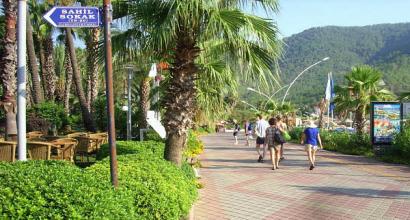Zagorsk Reservoir: fishing surrounded by pristine nature. Zagorsk Reservoir An excerpt characterizing the Zagorsk Reservoir
The history of one of the most beautiful reservoirs in Crimea began in a non-trivial way. People still live to this day about how the King of Nepal, Mahendra, visited the peninsula in 1958. He was accompanied by his second wife, Ratna Lakshmi, who wished to take a bath in Yalta. But in those years there were problems with water supply throughout the southern coast of Crimea. The august lady had to soak in a bath of mineral water.
After this incident, Nikita Khrushchev (the head of the Soviet state in 1953-1964) issued a decree to immediately find a way out of the current situation. And already in 1961-62. The department of karstology and mudflows of the Institute of Mineral Resources of the Academy of Sciences of Ukraine carried out exploration for the future route of a hydrotunnel, through which water from the yayla could get to the taps of residents of the South Coast. In a fairly short time, this tunnel was built by metro builders from Tbilisi. Its seven kilometers stretch in the thickness of the Main Range of the Crimean Mountains and lead to Greater Yalta.
And the source of moisture itself originates in several reservoirs located in the upper reaches of the Belbek River. The first of them were built in 1964 near the villages of Schastlivoe and Klyuchevskoye. Following them, when water became scarce again, in 1975, the construction of the Zagorsk reservoir began, located in the upper reaches of the Kacha River. Initially, it was filled from the left tributary of the Kachi - Stil. Now food comes from both rivers, while the shape of the reservoir, bifurcating in the upper part into two branches, resembles a slingshot in outline. The hydraulic structure was built according to the design of the Crimean branch of the Ukrgiprovodkhoz Institute until 1986.
All reservoirs (Schastlivoe-1, Schastlivoe-2, Klyuchevskoye and Zagorskoye) form a single interconnected chain through which life-giving moisture rushes further into the tunnel, to the South Coast.
Among the Crimean artificial reservoirs of natural flow, Zagorskoye, with a volume of almost 28 million m3, is the fourth largest of fifteen, second only to Chernorechensky (64.2 million m3), Simferopol (36 million m3) and Partizanskoye (34.4 million m3 ).
The reservoir received its name from the flooded village of the same name. It can be found on maps of the USSR General Staff until the early 70s. In addition to him, in 1976, several more villages were liquidated in the district: Shelkovichnoye (Koush), Lesnikovo (Stilya), Okhotnichye, the village of Krymsky (Chair, Shakhty) along with an anti-tuberculosis sanatorium. This is because the surrounding areas have become a sanitary zone.
In 2012, articles appeared in the press on the topic of the unsafety of the reservoir. According to the participants in its construction, the former head of PMK-11 of the Krymvodstroy trust, Alexander Tsiruk, and the ex-head of the site, Vladimir Krasnyansky, in 1986 the object was not actually accepted by the state commission, since it turned out to be unfinished due to lack of funding. And today, in their opinion, there is a threat to residents of villages located in the Kacha River basin in the event of a reservoir breakthrough. And this can happen if a particularly strong flood passes through the spillway.
Due to the strategic nature of the site, access to the reservoir is blocked to this day, and there is a checkpoint at the entrance. Although there are many who want to admire this man-made water miracle, surrounded by forest. Moreover, there were and are fish in the lake: carp and crucian carp, silver carp and rudd, roach and perch. One way or another, fishing enthusiasts still find ways to spend several hours here.
For reference:
Reservoir volume 27.85 million m3
Mirror area – 156 hectares
Length – 3.25 km
Maximum width – 0.75 km
Maximum depth – 43 m
An earthen dam 48 m high, 760 m long and 10 m wide at the crest
According to the Reskomvodkhoz of the ARC
(c) Efimenko Anastasia
Mar 13, 2012 by the author in the sectionThe Zagorsk Reservoir is essentially an artificial reservoir with a volume of about 28 million cubic meters, filled with the waters of the small mountain river Kacha, which runs down from the mountains, then flows through the valley of the same name and flows into the Black Sea in the Sevastopol region.
A hydrotunnel through the Yalta Yayla with a height of 1270 m for water supply to Greater Yalta was built in 1964.
Water from the Zagorsk reservoir is pumped by a pumping station through a water pipeline to the Schastlivenskoye reservoir. Water is supplied from the Schastlivensky hydroelectric complex to the southern slopes of the Crimean Mountains by gravity through a 7.2 km long tunnel under the Yalta Yayla.

Created to supply the South Coast with drinking water, in fact, thanks to a comical incident that happened to the wife of King Mahendra of Nepal, who was visiting the Crimea. When his wife, while in Yalta, wanted to take a bath, due to the lack of water in the tap, she had to use bottled mineral water. This was the reason that N.S. Khrushchev, who was then the First Secretary of the CPSU Central Committee, personally ordered to solve the problem of water supply to the South Coast.
If your dog is a Yorkshire Terrier, then you know better than anyone else that dogs of this breed over time become full members of the family in which they live. So it's understandable why you want to pamper him and choose clothes that will make him look charming. However, clothes for Yorkies should be chosen so that the dog feels comfortable in them. You can find a large selection of clothes for your pet on the website
The reservoir was built in 1980 at the confluence of the left tributary, the Stilya River. Water from here is pumped through an 18 km long pipeline to the Schastlivoe-II reservoir, which is part of a complex of hydraulic structures in the upper reaches of Belbek. This entire complex system was built for the water supply of Greater Yalta (a 7-kilometer water pipeline was laid through Mount Ai-Petri -).
The volume of the reservoir is 28 million square meters. m; mirror area - 156 hectares; length - 3.2 km; maximum width - 0.75 km; maximum depth - 43 m. The earthen dam is 48 m high, 760 m long and 10 m wide at the crest. The length of the coastline is 11 km.
The facility is closed to the public, there is a checkpoint and a barrier at the entrance.
If you notice an inaccuracy or the data is out of date, please make corrections, we will be grateful. Let's create the best encyclopedia about Crimea together!
The reservoir was built in 1980 at the confluence of the left tributary, the Stilya River. Water from here is pumped through an 18 km long pipeline to the Schastlivoe-II reservoir, which is part of a complex of hydraulic structures in the upper reaches of Belbek. This entire complex system was built for the water supply of Greater Yalta (a 7-kilometer water pipeline was laid through Mount Ai-Petri -). The volume of the reservoir is 28 million square meters. m; mirror area - 156 hectares; length - 3.2 km; maximum width - 0.75 km; maximum depth - 43 m. The earthen dam is 48 m high, 760 m long and 10 m wide at the crest. The length of the coastline is 11 km. The facility is closed to the public, there is a checkpoint and a barrier at the entrance. Save changesOne story tells that during the visit of the King of Nepal to Yalta, his wife, Ratna Lakshmi, wanted to take a bath. But in those years there were shortages of fresh water and the queen had to soak in a bath with mineral water. After this incident, the leadership of the Soviet Country took up the problem of water supply to the South Coast decisively: a network of 23 reservoirs was built throughout the peninsula. One of the largest is Zagorskoye, near the village of Sinapskoye, Bakhchisaray district.
Photo of Zagorsk Reservoir:





This is interesting:
- 43 m - maximum depth,
- 48 m - height of the earthen dam,
- 0.75 km - maximum width of the reservoir,
- 3.25 km - length,
- 11.2 km - length of the coastline,
- 156 hectares - mirror area,
- 27.8 million m3 - volume of water.
How the reservoir was formed - history
To provide water to the resort city of Yalta, they came up with an unusual solution. We created a large hydraulic system consisting of four reservoirs on mountain rivers, spillway systems, water intake, a suction conduit made of two strands of steel pipes, and pumping stations. The Schastlivenskoe reservoir was built at an altitude of 400 m above sea level. The water flows by gravity through a seven-kilometer water pipeline to the city wastewater treatment plant.

The Zagorsk reservoir, built in 1986, became a reserve reservoir. The place was chosen at the confluence of two small Crimean rivers Kacha and Stil. It is located 100 meters below Schastlivensky, water from it has to be pumped with powerful pumps.
If necessary, water flows to Schastlivenskoye, and only then to the resort. The result was a complex and unique water supply system.
Video review:
What to see near the reservoir?
After construction was completed, the adjacent river valleys became a sanitary zone, and settlements were eliminated. The villages of Shelkovichnoye, Okhotnichye and Lesnikovo, as well as the village of Krymsky, disappeared from the map of Crimea. The surrounding area was deserted. The famous Krushany gardens have gone wild; only the monument to the partisans reminds of the village of Shelkovichny.
The shape of the reservoir resembles a slingshot, because it is filled with water from two rivers. The water in the mountain river Kacha is distinguished by its transparency and abundance of fish. It is home to ram, crucian carp, rudd, carp, silver carp, roach, and perch. Of the large animals, deer can be found in the surrounding groves.

Stilya is a large left tributary of the Kacha. Along the river there is a trail to the Stilya-Bogaz pass. It was here that there stood a temple built in honor of the Orthodox Saint Stylian, a river was named after him, as well as a pass and a settlement. Another well-known historical fact: in these parts there grew a ship grove, which consisted of pines and beeches; the fleet was built from it during the time of Admiral Fedor Fedorovich Ushakov.
In the vicinity of the Zagorsk reservoir there are spontaneous hiking trails to Ai-Petri, Yaman-Tash and Tepe Carmen. The slopes of the villages along the banks are overgrown with strong deciduous trees: beeches, hornbeams, pine trees. On the banks of the pond you can find blooming lavender and enjoy its aroma.
Is it possible to freely access the reservoir?
The territory is considered a water protection and sanitary zone; the site is closed to visitors; at the entrance there is a checkpoint and a barrier. It is prohibited to swim, fish, or litter in the reservoir. Only independent tourists, traveling through the Crimean mountains on foot or on bicycles, bypass the checkpoint and the ranger’s house. Cars must have a special permit.
How to get to the Zagorsk Reservoir?
To get to the reservoir, you first need to come to Bakhchisarai, then go by bus to Sinapsky, from the village to the barrier before entering on foot.
Zagorsk reservoir on the map of Crimea
GPS Coordinates: N 44 38.800 E 34 02.817 Latitude/Longitude


